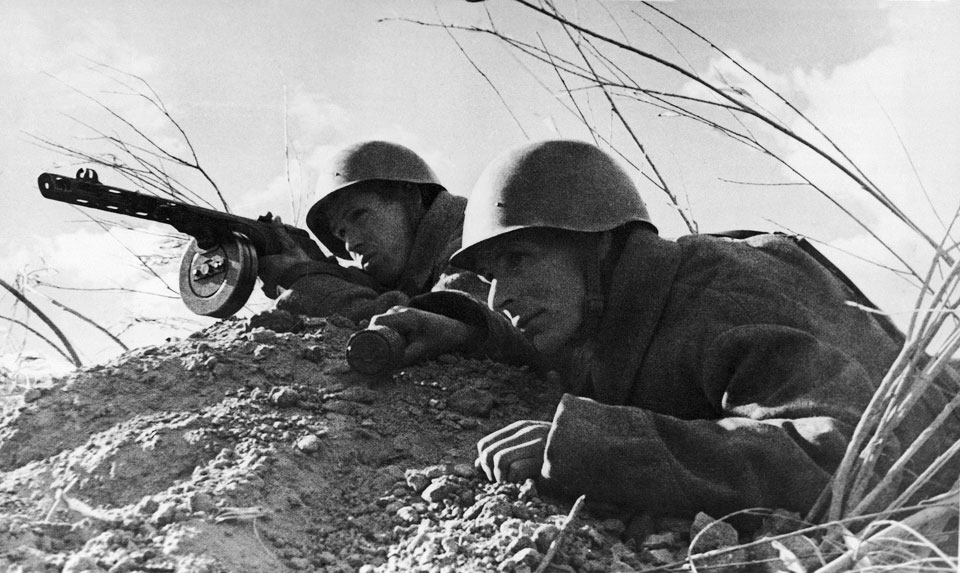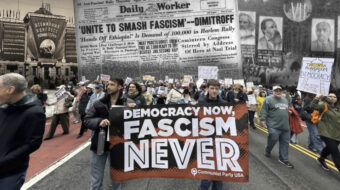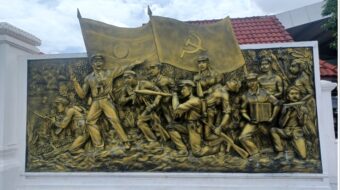
On the 75th Anniversary of D-Day today, there are ceremonies honoring the American heroes who landed on the beaches of Normandy and defeated the Nazis. This is as it should be. What is not right, however, is that rarely are we honoring in our ceremonies the Soviet heroes who bore the brunt of the battles to defeat fascism in World War II.
Americans are not surprised when they hear that historians distort the truth, but most of us believe it is foreign historians, not ours, who are in the business of distortion.
The truth about World War II is that the war against the Nazis was essentially already won a year or more before D-Day when American and British soldiers fought their heroic battle on the beaches of northern France. When General Dwight D. Eisenhower and the troops under his command landed at Normandy, however, the Soviet Union had already fought and won the decisive battles of the war.
The “second front” opened by our side came, in fact, much later than the Soviet Union had hoped. Soviet Premier Joseph Stalin had been pressuring U.S. President Franklin Roosevelt and British Prime Minister Winston Churchill for almost two years for the opening of a second front in Europe, arguing it would have spared many of the millions who eventually died on the continent.

President Trump, British Prime Minister Theresa May, and French President Emmanuel Macron made absolutely no mention this week in their commemorations of D-Day of the central and key role the Soviet Union played in the defeat of Nazism. (Trump commemorating the defeat of fascism is already an insult anyway, considering his support for fascistic leaders and movements in various places around the world, including his support for the extreme right in his own country.)
Trump is not alone to blame for ignoring the role of the USSR in winning the war. High on the list of those to blame are American history books themselves. Then, there is the U.S. media too, including supposedly progressive media, that rarely gives the Soviet Union credit for the victory over fascism.
In a recent article for CALmatters, Glenn Sacks, a California history teacher, shares a multiple choice question from the official California Subject Examinations for Teachers for Social Studies:
Which of the following events best marks the turning point of World War II?
A.) The Rape of Nanking by the Japanese
B.) Operation Barbarossa by the Nazis
C.) The D-Day invasion by the Allies
D.) The signing of the Rome-Berlin Axis
All four of the choices are incorrect. The makers of the test, however, want you to select “c.”
There is no arguing with the fact that D-Day was important and that American and British troops fought and died bravely, but D-Day was not a turning point when compared to major battles between Hitler’s troops and Soviet forces on the Eastern Front.
By the time D-Day happened, news broadcasts around the world had, for more than a year, already been describing how the war had turned into one of defeat after defeat and retreat after retreat for the Germans. The turning point or points then had already happened before D-Day.

Everyone, including President Roosevelt and Prime Minister Churchill, saw the Battle of Stalingrad, which raged for 162 days from August of 1942 until February of 1943, as the true turning point.
The German army, air force, and navy were running out of fuel. Stalingrad stood between the fascist troops and the massive Soviet oil fields of the Caucasus region, so the Germans had to take it if they ever were going to win the war.
Some two million people were killed or wounded in Stalingrad before the Nazis surrendered. Shipload after shipload of Soviet soldiers kept arriving and disembarking at the docks on the Volga River. They were strafed and bombed and killed by Nazi planes even before they reached shore. Thousands were shot to death in the waters into which they had jumped as their boats were sunk by the fascist pilots who sprayed them with bullets as they desperately tried to make it to shore.
Once in Stalingrad, a Soviet soldier was lucky if he lived an entire day. Supplies were short; two soldiers would share one rifle. The instructions were that when the first one dies the other one picks up the rifle and continues the fight. Yet they kept coming and they kept fighting, house to house and door to door, and then room to room until every last Nazi was cleared out of the city.
While some U.S. history books give slight or cursory mention to the epic battle, there are other Soviet battles too that were more significant militarily and politically than D-Day. These additional battles are almost never mentioned in our history books. One is the Battle of Kursk, the biggest tank battle in human history, that took place in July 1943. The Soviets defeated an army of over one million German soldiers.
Here, it is worth mentioning that not all of the problems with American history books are problems of omission. Some of them, in addition to leaving out important Soviet battles, inject falsehoods into their narratives. One of the most familiar of these is the notion that it was the cold Russian winter, rather than Soviet resolve or fighting ability, that really defeated the Nazis.
The Battle of Kursk, for instance, occurred during pleasant summer conditions and entirely on terms chosen by the Nazis, but they were still beaten.
Still another Soviet battle that surpassed D-Day happened after D-Day itself: Operation Bagration. At this battle, the Soviet Union inflicted on Germany the biggest defeat any nation had ever inflicted upon any other nation in the history of human warfare. The Soviets destroyed 60 German divisions, and yet again, more than a million more German soldiers.
Churchill rose up before the British parliament after this battle and declared: “The obvious essential fact to this point is that it is the Russian armies who have done the main work in tearing the guts out of the German army.”
Bagration was truly a turning point, too, because it led to a series of events that brought the Red Army all the way to the doorstep of Berlin.

First, in Byelorussia (modern-day Belarus) the Soviets destroyed 28 of 34 Divisions the Nazis sent there, effectively destroying, just a day after D-Day, the entire German front lines in the East. By June 24, they finished off the rest of the German armies and Panzer tank divisions in Byelorussia and liberated Minsk. That gave them a clear path to liberate Lithuania, Romania, and Poland, positioning themselves for the final offensive on the German capital.
There is much heroism to remember this “D-Day.” Some 400,000 U.S. soldiers heroically gave their lives fighting Hitler in the Second World War. In the east, the Soviet Union lost 27 million people; roughly every fifth person in that huge multi-national country gave their lives.
No Western leaders argued at that time with the figures, figures which showed 80 percent of German casualties were caused by the Soviet Union and its people. General Eisenhower himself testified to the destruction by the Nazis of one-third of the wealth of the Soviet Union and how, after the war, they had to find homes for 25 million homeless people. Eisenhower is quoted as having said, “When we flew into Russia, in 1945, I did not see a house standing between the western borders of the country and the area around Moscow.”
So on this D-Day, let’s remember the Americans in the “greatest generation” who died fighting the menace of fascism. But let’s also remember our Soviet brothers and sisters who died fighting that battle. We owe them and, just as important, ourselves no less.
Like free stuff? So do we. Here at People’s World, we believe strongly in the mission of keeping the labor and democratic movements informed so they are prepared for the struggle. But we need your help. While our content is free for readers (something we are proud of) it takes money — a lot of it — to produce and cover the stories you see in our pages. Only you, our readers and supporters, can keep us going. Only you can make sure we keep the news that matters free of paywalls and advertisements. If you enjoy reading People’s World and the stories we bring you, support our work by becoming a $5 monthly sustainer today.










